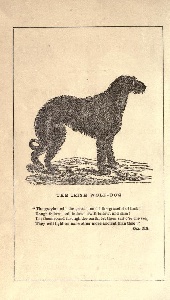StandardS
Standard du Greyhound par le Kennel Club, Angleterre.
ATTENTION, voici le standard anglais du greyhound par lequel j'ai choisi de commencer car le standard du deerhound fait plusieurs fois référence à cette race .........
Standard FCI du Greyhound
ATTENTION, voici le standard FCI du greyhound par lequel j'ai choisi de commencer car le standard du deerhound fait plusieurs fois référence à cette race .........
Standard FCI
Standard FCI N°164/17.06.1998/F
Traduction du Professeur R. Triquet.
Date de publication du standard en vigueur: 24.06.1987
Origine Grande-Bretagne.
Utilisa...
Standard du Kennel Club (UK)
General AppearanceResembles a roughcoated greyhound of larger size and bone.
CharacteristicsThe build suggests the unique combination of speed, power and endurance necessary...
Standard AKC (USA)
Scottish Deerhound breed standard
Standard illustré
Hound group
Head Should be broadest at the ears, narrowing slightly to the eyes, with the muzzle tapering more decidedly...
Standard du Canadian Kennel Club
Deerhound (Scottish)
Size
Height: Dogs from 30-32 inches (76-81 cm), or even more if there be symmetry without coarseness, which is rare.
Bitches from 28 inches (71 cm) u...
Standard ANKC (Australie)
Idem UK Kennel Club. http://www.ankc.org.au/Breed_Details.aspx?bid=117
Description du Victorian Club:
The Deerhound, the Royal Dog of Scotland, has been bred in t...
Commentaire Barbara Heidenreich, élevage Fernhill.
A l'occasion de la Nationale d'élevage finlandaise 2007.
Finnish Deerhound Specialty August 4, 2007 – Judge’s Impressions
A National Specialty is a time to celebrate y...
Premier Standard 1892
En fait une description faite par Mr Hickmann et Mr Hood Wright, arrangée, puis approuvée le 26 novembre 1892 par le Scottish Deerhound Club qui venai...
1884, Our Dogs And Their Diseases, G.S. Heatley
Extrait de "Our Dogs And Their Diseases" 1884, G.S. Heatley. LIEN
The Scotch Greyhound
"...The Glengarry breed measures twenty-eight inches, and thirty-four inches...
1882, The Dogs of the British Islands, J.H. Walsh
LIEN
Suite à une description qui ressemble déjà à un standard, l'exemple concerne un chien qui aurait toisé 32 pouces soit 81cm.
"...The measurement of Bran...

1874 Dogs: their origin and varietes H.D. Richardson.
Extrait de "Dogs; their origin and varieties" H.D. Richardson 1874. LIEN
THE HIGHLAND DEERHOUND. This dog is, as I have shown, the modern representative, unch...
1867, Histoire ...des Chiens...B.H. Revoil & Alexandre Dumas.
"Histoire psychologique et anecdotique des chiens de toutes les races".
1867 Benedict Henry Revoil & Alexandre Dumas
Deerhound, pages 223/224.
Taille: 70 à 80 cm.&...
1864. "Les chasses en France et en Angleterre; histoire de sport."
1864. "Les chasses en France et en Angleterre; histoire de sport." René Caillard.
Incontournable récit de chasse.
A lire Chapitre XX; La chasse des cerfs et les deerhou...
1863 Bulletin de la Societé Impériale de Zoologie.
LIEN
Page 57.
Taille du deerhound: 70 à 75 cm.
1861. The House Dogs and Sporting Dogs. John Meyrick
Page 7, etc...
Taille deerhound; 28 pouces et plus, soit 71 cm et plus, et un exemple de 31 pouces soit 79 cm.
LIEN
1859. The Dog, in Health and Disease. J.H. Walsh (Stonehenge)
Taille, certains ont 28 pouces (71cm), mais le plus souvent 26.5 à 27.5 pouces (67.3 à 68.5cm).
LIEN
1857. Dogs. G.F. Pardon
Pages 48/49/50/256/260.
LIEN
1857.The Complete Manual for Young Sportmen.H.W.Herbert& F.Forester
Pages 232,...
Taille deerhound; 91.5 à 99 cm.
Etonnant ???, ne convertissez pas les mesures de tour de poitrine, ça devient ahurissant...
LIEN
1856. Manual of British Rural Sports. J.H. Walsh (Stonehenge)
Pages 86/87 + 97
Taille deerhound mâle: 28 inch, 76 cm.
LIEN
1847. Days of Deer-Stalking in the ScottishHighlands. W. Scrope.
Très important; "Communiqué par Archibald MacNeill esq of Colonsay"
Taille deerhound; environ 76cm et 45.5 kg.
LIEN
1846. The New Sporting Magazine.
Page 339...
Taille deerhound: 28 à 33 pouces (71 à 84 cm) pour 100 livres (45,5 kg) annoncés, ramenés selon l'auteur, H.D. Richardson, à 27.5 pouces (70 cm) et 70 à 75 l...
1844. Du Chien Domestique et du Coq. J.D. Hannon
1844. Du Chien Domestique et du Coq. J.D. Hannon
LIEN
Page 73
1845, Annales des Uniersités de Belgique.
LIEN
Page 173
1841. The Irish Penny Journal.
Pages 354,....
taille deerhound mâle:
-Exemple Oscar à Mr Nolan: 72.5 cm
-parfois 76cm
LIEN
1839. American Turf Register and Sporting Magazine.
Pages 649, etc...
"... The following are the dimensions of Buskar, taken in august 1836:
...ci-après les dimensions de Buskar, relevées en août 1836:
-Height at the shoulde...
1838. The Art of Deerstalking. William Scrope.
Taille deerhound; environ 76 cm.
LIEN
1803. Nouveau Dictionnaire d'Histoire Naturelle
1803. Nouveau Dictionnaire d'Histoire Naturelle. Jacques Delille.
Page 115.
LIEN





